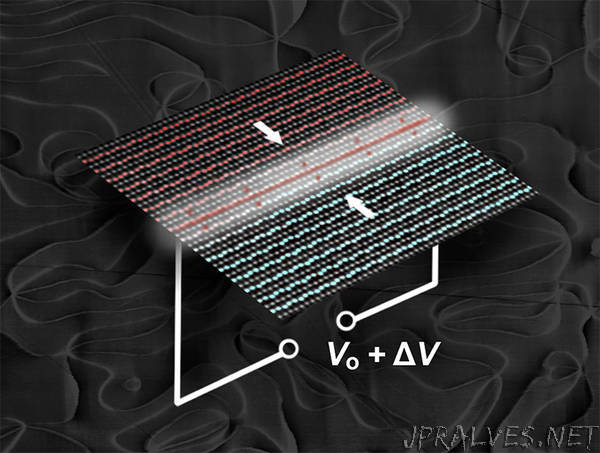
“An electric field switches the conductivity on and off in atomic-scale channels, which could allow for upgrades at will.
Updating, rather than replacing, outdated circuits in tiny sensors would reduce cost and waste. The unusual electronic properties of ferroelectric domain walls could be the answer. A domain wall is the interface between different types of electrical ordering. Applying a voltage to the domain wall can change the preferred electrical ordering, making the domain walls move. These walls can be made, moved, and erased on demand, making them promising for next-generation circuit elements. Advanced electron microscopy allowed scientists to see that electrons move to the wall to create one-nanometer channels. Applying a voltage reversibly switches the channel from insulating to conducting, which could be used as the 0’s and 1’s for binary switches in a computer.
The Impact
Rewriteable domain walls are a promising avenue for extremely small circuitry. Reversibly switching conductivity on and off with an electric field is a critical step towards using these walls in digital devices. These devices include switches, diodes, or field-effect transistors.
Summary
Ferroelectric materials have spontaneous electrical ordering that can be changed by applying an electric field. Where two domains of different polarizations meet, it is called a ferroelectric domain wall. These domain walls are promising for next-generation circuit elements due to their unusual electronic properties and because they can be formed, moved, and erased on demand. At “charged” domain walls, the mismatch in polarization between the two domains forces a build-up of charge at the wall.
Scientists envision a transistor where the gate is a domain wall itself—and whether you can pass current through the domain wall is controlled by the charges in the domain wall. Now, scientists have found that they can reversibly switch domain walls between being resistive or conductive depending on the electric field they apply. Using atomic-resolution electron microscopy and spectroscopy, they found that the electrons that move to the wall were confined to just one to two repeating crystalline unit cells in erbium manganite (ErMnO3). When the polarizations of the two ferroelectric domains point at each other (head-to-head), there is nominally a buildup of positive charge at the domain wall. This positive charge was compensated by extra electrons that accumulated on the atoms within the domain wall. These electrons were stuck, shielding the local charges, and did not conduct. By applying an electric field, extra electrons flowed into the channel at the domain wall. When all the local charges were sufficiently shielded, the electrons in the channel were free to move within the domain wall, forming a 2-D conductive sheet. This conductive sheet could be used as a switch or transistor. The switch is “off” when current does not flow. Applying an electric field allows current to pass, turning the switch “on.” This paves the way towards developing all-domain-wall electrical devices.”
